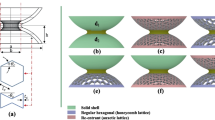Abstract
Materials presenting a negative Poisson’s ratio (auxetics) have drawn attention for the past two decades, especially in the field of lightweight composite structures and cellular media. Studies have shown that auxeticity may result in higher shear modulus, indentation toughness and acoustic damping. In this work, three auxetic periodic microstructures based on 2D geometries are considered for being used as sandwich-core materials. Elastic moduli are computed for each microstructure by using finite elements combined with periodic homogenization technique. Anisotropy of elastic properties is investigated in and out-of-plane. Comparison is made between auxetics and the classical honeycomb cell. A new 3D auxetic lattice is proposed for volumic applications. Cylindrical and spherical elastic indentation tests are simulated in order to conclude on the applicability of such materials to structures. Proof is made that under certain conditions, auxetics can be competitive with honeycomb cells in terms of indentation strength. Their relatively soft response in tension can be compensated, in some situations, by high shear moduli.





























Similar content being viewed by others
References
Alderson, K.L., Pickles, A.P., Neale, P.J., Evans, K.E.: Auxetic polyethylene—the effect of a negative Poisson ratio on hardness.Acta Metall. Mater. 42(7), 2261 (1994)
Alderson, K.L., Fitzgerald, A., Evans, K.E.: The strain dependent indentation resilience of auxetic microporous polyethylene. J. Mater. Sci. 35(16), 4039 (2000)
Alderson, v., Alderson, K.L., Attard, D., Evans, K.E., Gatt, R., Grima, J.N., Miller, W., Ravirala, N., Smith, C.W., Zied, K.: Elastic constants of 3-, 4-and 6-connected chiral and anti-chiral honeycombs subject to uniaxial in-plane loading. Compos. Sci. Technol. 70(7), 1042 (2010)
Almgren, R.F.: An isotropic three-dimensional structure with poisson’s ratio = −1. J. Elast. 15, 427 (1985)
Ashby, M.F., Bréchet, Y.: Designing hybrid materials. Acta Mater. 51, 5801 (2003)
Bunge, H.J.: Texture Analysis in Materials Science. Butterworths, London (1982)
Caddock, B.D., Evans, K.E.: Microporous materials with negative poisson’s ratios: I. Microstructure and mechanical properties. J. Phys. D 22, 1877 (1989)
Chen, C.P., Lakes, R.S.: Micromechanical analysis of dynamic behavior of conventional and negative Poisson’s ratio foams. J. Eng. Mater. Technol. 118(3), 285 (1996)
Choi, J.B., Lakes, R.S.: International Journal of Fracture 80, 73 (1996)
Dirrenberger, J., Forest, S., Jeulin, D., Colin, C.: Homogenization of periodic auxetic materials. Procedia Eng. 10, 1847 (2011). doi:10.1016/j.proeng.2011.04.307
Dirrenberger, J., Forest, S., Jeulin, D.: Elastoplasticity of auxetic materials. Comput. Mater. Sci. (2012). doi:10.1016/j.commatsci.2012.03.036
Doyoyo, M., Hu, J.W.: Plastic failure analysis of an auxetic foam or inverted strut lattice under longitudinal and shear loads. J. Mech. Phys. Solids 54, 1479 (2006)
Evans, K.E., Nkansah, M.A., Hutchinson, I.J., Rogers, S.C.: Molecular network design. Nature 353, 124 (1991a)
Evans, K.E.: The design of doubly curved sandwich panels with honeycomb cores. Compos. Struct. 17(2), 95 (1991b)
Gaspar, N., Ren, X.J., Smith, C.W., Grima, J.N., Evans, K.E.: Novel honeycombs with auxetic behaviour. Acta Mater. 53, 2439 (2005)
Huang, X., Blackburn, S.: Developing a new processing route to manufacture honeycomb ceramics with negative Poisson’s ratio. Key Eng. Mater. 206-213, 201 (2002)
Jean, A., Engelmayr, G.C.: Finite element analysis of an accordion-like honeycomb scaffold for cardiac tissue engineering. J. Biomech. 43, 3035 (2010)
Kanit, T., Forest, S., Galliet, I., Mounoury, V., Jeulin, D.: Determination of the size of the representative volume element for random composites: statistical and numerical approach. Int. J. Solids Struct. 40, 3647 (2003)
Lakes, R.S.: Foam structures with a negative poisson’s ratio. Science 235, 1038 (1987)
Lakes, R.S.: Deformation mechanisms in negative poisson’s ratio materials: structural aspects. J. Mater. Sci. 26, 2287 (1991)
Milton, G.W.: Composite materials with poisson’s ratios close to −1. J. Mech. Phys. Solids 40(5), 1105 (1992)
Lakes, R.S.: Materials with structural hierarchy. Nature 361, 511 (1993)
Lipsett, A.W., Beltzer, A.I.: Reexamination of dynamic problems of elasticity for negative Poisson’s ratio. J. Acoust. Soc. Am. 84(6), 2179 (1988)
Madi, K., Forest, S., Cordier, P., Boussuge, M.: Numerical study of creep in two-phase aggregates with a large rheology contrast: implications for the lower mantle. Earth Planet. Sci. Lett. 237(1-2), 223 (2005). doi:10.1016/j.epsl.2005.06.027
Mitschke, H., Schwerdtfeger, J., Schury, F., Stingl, M., Körner, C., Singer, R.F., Robins, V., Mecke, K., Schröder-Turk, G.E.: Finding auxetic frameworks in periodic tessellations. Adv. Mater. 23, 2669 (2011)
Prall, D., Lakes, R.S.: Properties of a chiral honeycomb with a poisson’s ratio of −1. Int. J. Mech. Sci. 39(3), 305 (1997)
Scarpa, F., Yates, J.R., Ciffo, L.G., Patsias S.: Dynamic crushing of auxetic open-cell polyurethane foam. J. Mech. Eng. Sci. 216(12), 1153–1156 (2002)
Schwerdtfeger, J., Heinl, P., Singer, R.F., Körner, C.: Auxetic cellular structures through selective electron-beam melting. Phys. Status Solidi 247(2), 269 (2010)
Spadoni, A.: Application of chiral cellular materials for the design of innovative components. Ph.D. thesis, Georgia Institute of Technology. (2008)
Spadoni, A., Ruzzene, M., Gonella, S., Scarpa, F.: Phononic properties of hexagonal chiral lattices. Wave Motion 46(7), 435 (2009)
Acknowledgments
This work is part of the MANSART (Architectured sandwich materials) project ANR-08-MAPR-0026. Financial support of ANR is gratefully acknowledged.
Author information
Authors and Affiliations
Corresponding author
Rights and permissions
About this article
Cite this article
Dirrenberger, J., Forest, S. & Jeulin, D. Effective elastic properties of auxetic microstructures: anisotropy and structural applications. Int J Mech Mater Des 9, 21–33 (2013). https://doi.org/10.1007/s10999-012-9192-8
Received:
Accepted:
Published:
Issue Date:
DOI: https://doi.org/10.1007/s10999-012-9192-8




